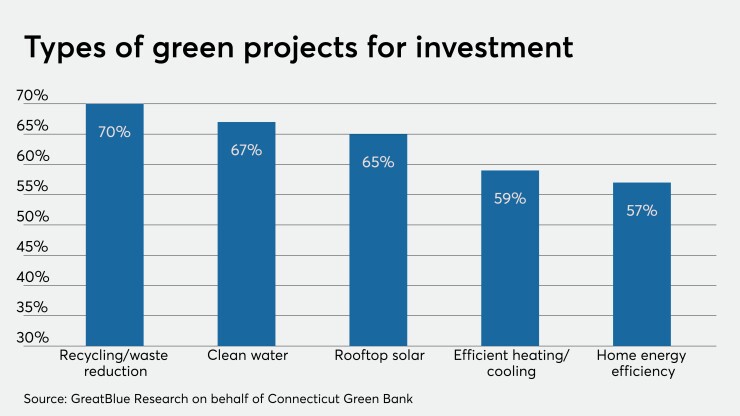Connecticut Green Bank, the nation’s first state-level green bank, plans to launch its Green Liberty Bonds next week.
The Rocky Hill-based bank will offer $16 million of the state-supported solar home renewable energy credit to retail and institutional investors Tuesday and Wednesday, respectively.
Proceeds of the bonds, available to individual investors in $1,000 denominations, will be independently certified as financing projects with climate and environmental benefits.
Ramirez & Co. is senior manager. Stifel is co-manager.
While federally taxable, they are tax-exempt for Connecticut residents.

“Climate change is real and there is so much more to do,” the bank’s chief executive, Bryan Garcia, said on an investor call. “We wanted to create a financial instrument that allows Americans to invest in the climate economy and the future they want to see."
S&P Global Ratings rated the bonds A, with a stable outlook.
“We are excited to be part of the issuance of this new type of green bond with a focus on bringing retail investors to the table,” said Ramirez Senior Vice President Brad Friedman.
Proceeds will refinance expenditures of the bank to its residential solar incentive program and fund a special capital reserve fund.
According to Garcia, the bonds will commemorate the 50th anniversary of Earth Day, observed in April. They are modeled after World War II Series E bonds, which more than 80 million Americans purchased and provided $185 billion in revenue.
First Lady Eleanor Roosevelt visited Hartford in 1943 to promote war bond sales alongside the Girl Scouts at the Bushnell theater, now the Bushnell Performing Arts Center.
“Connecticut has a rich history in terms of innovation,” Garcia said.
The quasi-public Green Bank began in 2011 as a successor to the Connecticut Clean Energy Fund, with an emphasis on financing clean energy initiatives, including renewable energy, energy efficiency, energy storage, alternative fuel vehicles, and infrastructure.
While it’s not a state agency, the state treasurer is an ex-officio board member.
Its support comes from a variety of sources, including $26 million annually from a surcharge on electric ratepayer bills and up to $5 million per year in Regional Greenhouse Gas Initiative allowance proceeds. Other sources include the federal government and private capital.
Similar banks have launched in other states. When Rhode Island began its state infrastructure bank in 2015, officials referenced the Connecticut Green Bank.
“The folks there have done some good work,” Rhode Island General Treasurer Seth Magaziner said at the time.
Kestrel Verifiers of Hood River, Oregon, has ensured the bonds meet the solar standard of London-based Climate Bonds Initiative. The Green Bank and Kestrel will report annually on the impact of the projects associated with the bonds.
While the Green Liberty Bond will be a new offering, the Green Bank previously issued three privately placed bonds, including a $38.6 million offering in two tranches in April 2019 that monetized the solar home renewable energy credits generated through Connecticut’s Residential Solar Investment Program.
That program provides homeowners with a rebate of 0.46 cents per watt to help offset the costs of installing residential solar power.
The 2019 deal marked the bank’s inaugural rated debt issuance, and the first solar asset-backed security transaction by a green bank. It won awards for green-bond issuance from the website Environmental Finance.
Lamont Financial Services is the municipal advisor for the upcoming sale. Shipman & Goodwin LLP is bond counsel. Kutak Rock LLP is the underwriter's counsel. Bank of New York Mellon is the trustee. DNV-GL is the independent engineer.
Closing date is July 29.





